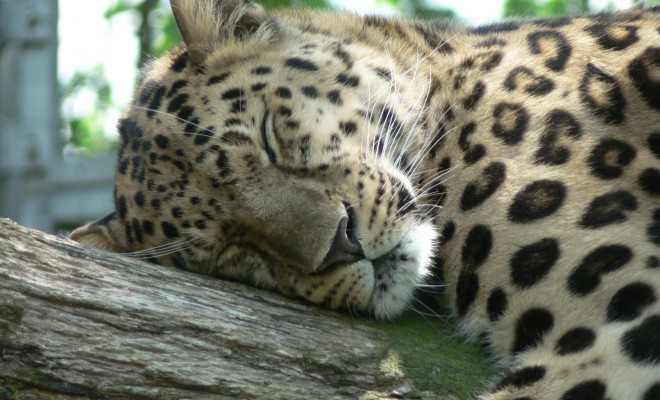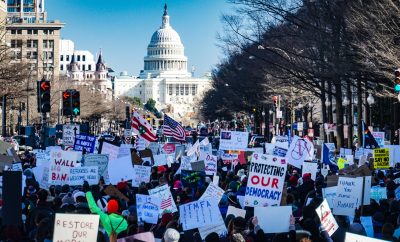 Image courtesy of [Nick@ via Flickr]
Image courtesy of [Nick@ via Flickr]
Health & Science
Endangered Species Protections: Are We Doing Enough?
One decade ago, the iconic Bald Eagle lived up to the American dream by defying extinction.
At the dawn of the 20th century, the majestic bird of prey found itself in peril, and not from natural causes. The Bald Eagle’s plight resulted from man-made difficulties. In the early years, hunting and logging threatened the birds, then the pesticide DDT came onto the scene. DDT ended up in the eagles’ food and caused them to lay weak, inviable eggs. Thus, the eagle population plummeted.
Americans scrambled to protect their favorite bird. The Bald Eagle Protection Act of 1940 outlawed the shooting, poisoning, or killing of Bald Eagles, DDT was banned, and Bald Eagles became one of the first species protected under the new Endangered Species Act of 1973.
In 2007, the government removed them from the endangered species list, proving the success of environmental programs and offering hope to species on the brink.
While Bald Eagles escaped extinction, many other species haven’t been so lucky. Habitat destruction, human construction, poaching, and even climate change close in on animals every day, threatening the balance of our interconnected ecosystem. Here’s an overview of what we’re doing to protect endangered species and what else we could be doing.
What does it mean to be an endangered species?
Here’s a quick rundown on how we define endangered species.
The Basics
“Endangered” is an official government designation created by the Endangered Species Act of 1973.
Animals who earn the title:
- Receive protection from potentially harmful federal activities, meaning that agencies have to consider endangered species in their authorization and funding decisions;
- Can’t be transported, sold, or “taken,” which bans any activities that can kill or harm the animal like shooting, trapping, hunting, and pursuing;
- Become eligible for U.S. Fish and Wildlife Service (FWS) recovery plans. The plans evaluate research and protocols to determine needs for successful species recovery; and,
- Could be supplied with habitats if needed, purchased by the U.S. Fish and Wildlife Service (FWS).
Protection is enforced by the U.S. Fish and Wildlife Service (FWS), a section of the Department of the Interior and the National Marine Fisheries Service (NMFS), part of the the National Oceanic Atmospheric Administration.
How do animals get the designation?
Endangered species are simply species in imminent danger of becoming extinct. A “threatened” designation refers to species at risk for becoming endangered soon.
Common things that can endanger a species are:
- Destruction or alteration of habitat.
- Overuse for education, scientific, commercial, or recreational purposes.
- Disease.
- Predation.
- Any natural or man-made factors that affect survival, which could cover a number of human activities.
After establishing those factors, “candidates” for the list run through a thorough review process that could take up to two years. In that time, experts submit biological information on the species that will help inform the decision. In the review, experts consider the severity of the threat, how soon the extinction could happen, and the uniqueness of the species. You can check out the current list of candidates here.
Once a species gets on the list, the authorities reevaluate that case every five years to see if a classification should be removed or changed.
The ESA is an American law, yet many endangered species like tigers and gorillas aren’t in the United States. In these cases, the ESA enforces bans and limits on trade in endangered animal body parts.
Opposition to the Current Policies
Protecting species often clashes with other interests. Recently, the government listed the Long-Eared Bat as a threatened species. But farming, timber, oil, and gas interest groups claimed that protecting the bat restricts them from certain practices and would drive up costs of their operations. Use of wind turbines, natural gas wells, and pesticides would all be restricted in order to protect the bat. Organizations plan to continue voicing their concerns as the threatened designation moves toward enforcement next month.
Listen to more about the controversy via NPR:
Problems With the Current Policies
Like the Bald Eagle, some species have recovered enough to be removed from the endangered species list. Sadly, those successes are mere droplets in an entire ocean of worry. Many of the vulnerable species at risk of extinction don’t even make it on to the endangered species list and have no other source of protection. For example, according to the World Wildlife Federation’s (WWF) 2014 Living Planet Report, the populations of all vertebrate species have declined by 52 percent in the last 40 years.
Extinction means more than the life or death of a given species, as many animals influence our ecosystem, economy, and food security in ways we can’t realize until they’re gone. The loss of one species could create a devastating domino effect. The case of the Bonobo, a type of chimpanzee, makes a perfect example of what can happen when species’ decimation continues unchecked.
The Plight of the Bonobo
Bonobos face extinction as a result of poaching from the bushmeat trade. But Bonobos themselves aren’t the only thing that we need to worry about when considering their extinction. Studies have found that a majority of plants and trees in the Democratic Republic of the Congo need Bonobos to spread their seeds and will not reproduce unless their seeds are first “processed” by the Bonobo; this means that the Bonobos’ stomach acids break down hard seed coatings and enable them to sprout. Plant growth depends on each Bonobo. On average, every Bonobo processes about 11.6 million seeds in its lifetime.
Their extinction would set off a chain reaction: loss of trees and plants, loss of other species that lived among the trees and plants, and eventually we’d reach a stillness known as empty forest syndrome, where large vertebrate populations dwindle to nothing. According to biologist David Beaune, the same thing could happen in ecosystems that unknowingly rely on other chimpanzees, gorillas, and apes that “process” and spread seeds.
U.S. Protective Actions
Last year, President Obama signed an executive order for a National Strategy for Combating Wildlife Trafficking to address the illegal wildlife trade. The strategy emphasized three priorities:
- Strengthening enforcement of wildlife trafficking bans.
- Cutting the illegal wildlife trade at home and abroad.
- Strengthening partnerships in efforts to combat illegal wildlife trade and poaching.
Altogether, the strategy cracks down on the market for illegal wildlife trade as a strategy to protect animals. As Harrison Ford says in the PSA below, “When the buying stops, the killing does too.”
In February 2015, the Departments of State, Justice, and the Interior released the Implementation Plan for the strategy, which outlines specific steps that the President’s Task Force on Combating Wildlife Trafficking need to take and how its progress will be measured. You can access the full plan to read about the specific steps proposed to address the three strategic priorities bulleted above.
One example of the strategy at work is Operation Crash, a proactive criminal enforcement initiative that aims to search and reprimand people who hunt and kill rhinos or traffic their horns. Operation Crash has made 26 arrests and convicted 18 perpetrators. You can check out examples of the convictions here.
While this is excellent progress, the National Wildlife Federation recommends full participation in recovery programs and encourages stakeholders to produce measurable recovery targets that go beyond the safety net features of the Endangered Species Act. It acknowledges the need to stop the killing, but wants to see more proactive recovery assistance options.
Is “de-extinction” possible?
In the introduction of the WWF Living Planet Report 2014, Director General Marco Lambertini encourages people to take up the difficult but crucial responsibility of protecting wildlife.
Difficult, certainly, but not impossible – because it is in ourselves, who have caused the problem, that we can find the solution. Now we must work to ensure that the upcoming generation can seize the opportunity that we have so far failed to grasp, to close this destructive chapter in our history, and build a future where people can live and prosper in harmony with nature. We are all connected – and collectively, we have the potential to create the solutions that will safeguard the future of this, our one and only planet.
After all, we can’t bring species back once they’re gone. Or can we?
In the following video, writer Stewart Brand discusses the possibilities of a “dawn of de-extinction,” the reality of bringing species back from well beyond the brink by reassembling an entire genome using ancient DNA. He discusses how geneticist George Church has created a multiplex automated genome engineering machine that tests ancient DNA combinations for viability in living organisms. Combinations that win can be used to synthetically hybridize the genome of an extinct species with the genome of its closest living relative.
So theoretically, we might be able to resurrect lost species. But in the meantime, we should focus on protecting the species that are still around.
Resources
Primary
U.S. Fish and Wildlife Service: Listing a Species as Threatened or Endangered
U.S. Department of Justice: The Fight Against Wildlife Trafficking
Additional
National Geographic: Bald Eagles Soar Off Endangered Species List, But Will Act Be Weakened?
World Wildlife Federation: Living Planet Report 2014
National Wildlife Federation: Keeping the Endangered Species Act Strong
Oryx Journal: What Would Happen to the Trees and Lianas if Apes Disappeared?
Scientific American: If Apes Go Extinct, So Could Entire Forests








Comments